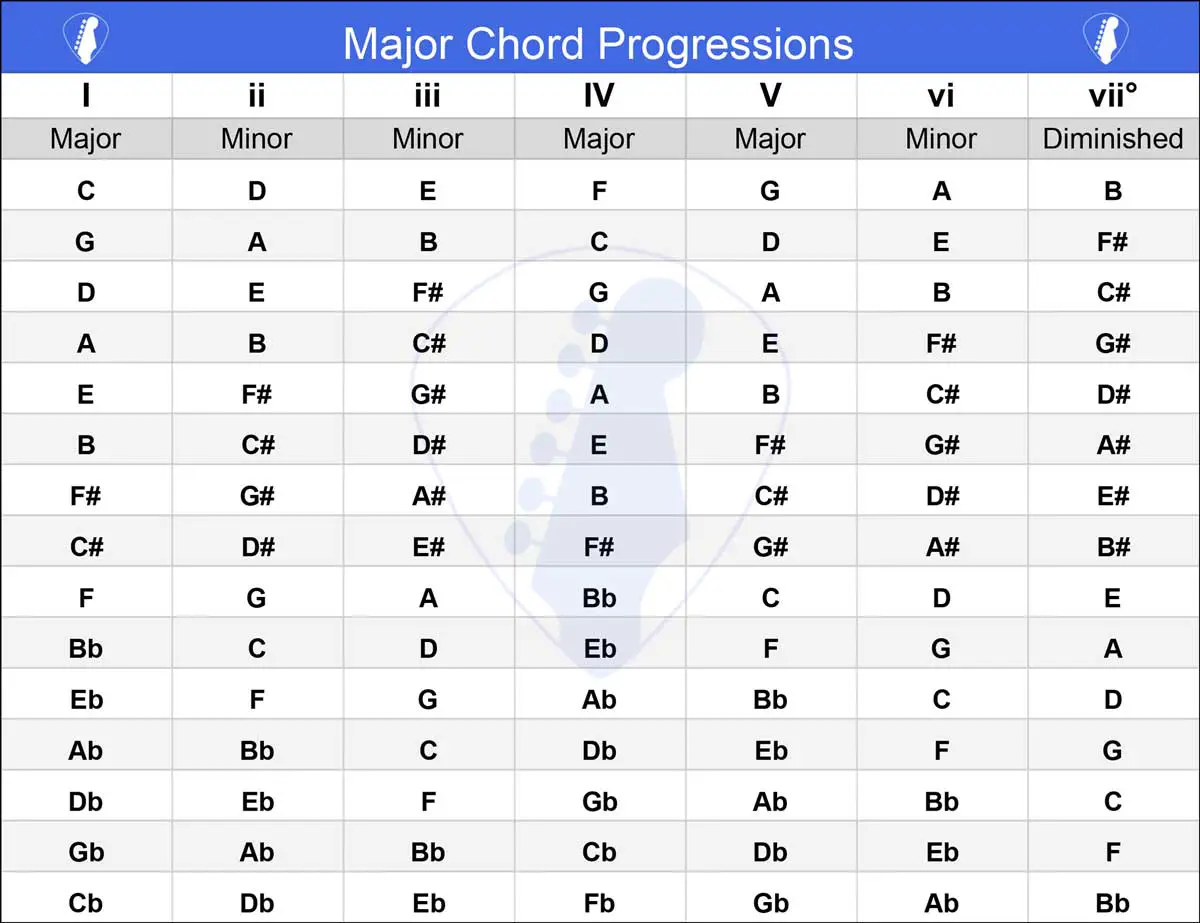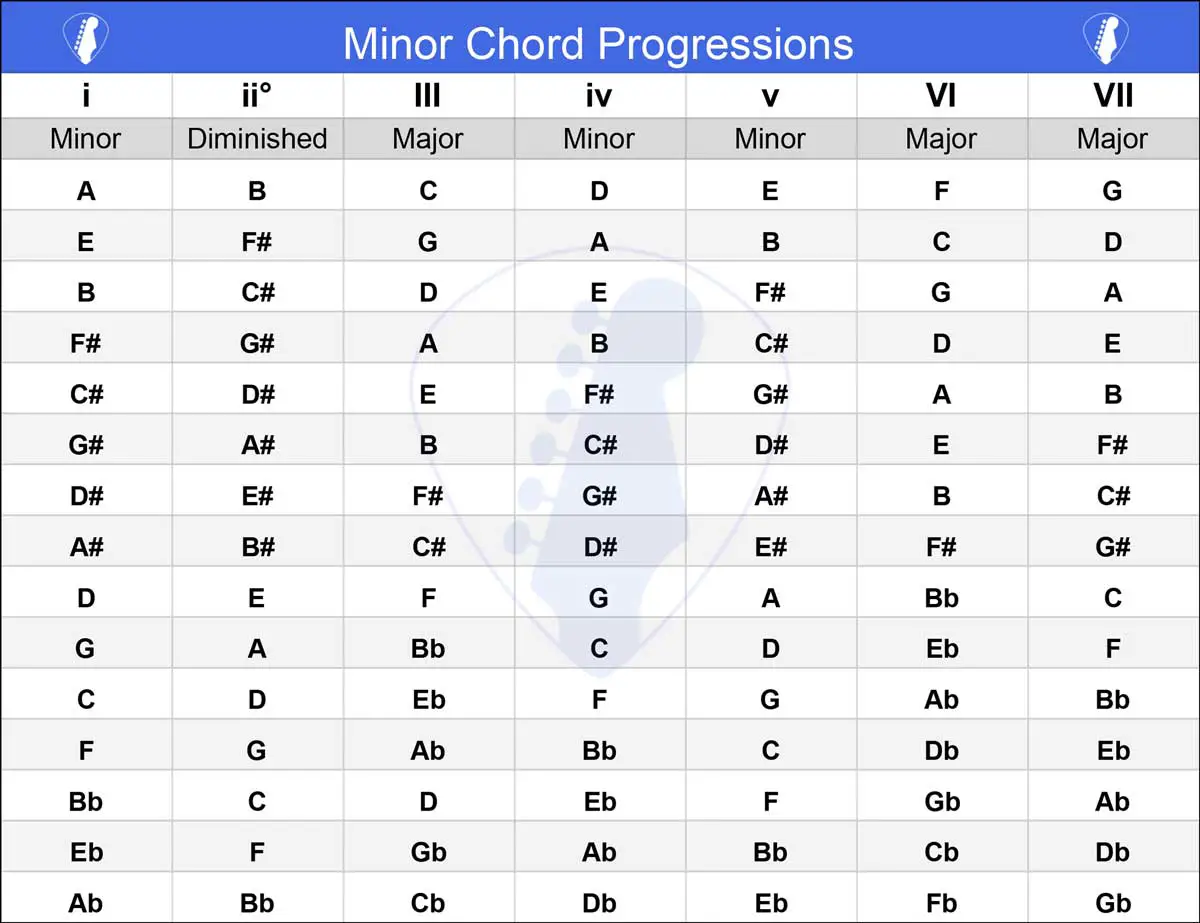A chord progression is a sequence of chords played in a specific order to create a harmonic framework within a piece of music. Chord progressions form the backbone of a song’s harmonic structure and contribute to its mood and emotion. A chord progressions chart is a handy reference tool that lists the chords included in any given key.
They can be used for songwriting, composing, teaching students, and getting musical inspiration. They provide a great base for musicians to add their own unique elements. In this article we provide a chord progression chart for both major and minor keys, so you can use them to write music in any key.

Chord Progression Basics
A chord progression is a series of chords played in a specific order. These chords are built from the notes of a scale and are combined to create harmony. Chord progressions are important because they help define the changes in a song and guide its harmonic movement.
Chord progressions are often described using Roman numerals that correspond to the degree of each chord in a particular key. For example, in the key of C major, the I chord is C major, the IV chord is F major, and the V chord is G major. This system allows you to easily transpose progressions to different keys.
Lastly, different chord progressions evoke different emotions. Major progressions generally sound bright and happy, while minor progressions often convey sadness or introspection.
While common progressions provide a solid foundation, don’t be afraid to experiment and create your own unique sequences. Music theory can guide you, but your ear and intuition are just as important.
Related: Major Chord Progressions
The Difference Between Major and Minor
One of the biggest differences between major and minor keys is the chord qualities in their progressions. The difference in chord quality between major and natural minor scales play a crucial role in creating the characteristic emotional and harmonic textures associated with each scale. Here are the qualities of both major and (natural) minor keys:
Major Scale Chord Qualities:
| Scale Degree | Roman Numeral | Chord Quality |
|---|---|---|
| Tonic | I | Major |
| Supertonic | ii | Minor |
| Mediant | iii | Minor |
| Subdominant | IV | Major |
| Dominant | V | Major |
| Submediant | vi | Minor |
| Leading Tone | vii° | Diminished |
Natural Minor Scale Chord Qualities:
| Scale Degree | Roman Numeral | Chord Quality |
|---|---|---|
| Tonic | i | Minor |
| Supertonic | ii° | Diminished |
| Mediant | III | Major |
| Subdominant | iv | Minor |
| Dominant | v | Minor |
| Submediant | VI | Major |
| Subtonic | VII | Major |
***When harmonizing melodies or composing chord progressions in minor keys, variations such as harmonic and melodic minor scales can be used to introduce further complexity and color to the chords.***
Related: Minor Chord Progressions
How To Read A Chord Progression Chart
Understanding how to read a chord progression chart is a fundamental skill for new guitar players. A chord progression chart displays a sequence of chords that are played in a particular order, typically represented by Roman numerals.
Each numeral corresponds to a chord based on its scale degree within a key. For example, in the key of C major, the numeral “I” represents a C major chord, “ii” stands for D minor, and so on.
To use the chart, start by selecting the key you wish to play in, then follow the sequence of numerals to play the progression. Remember, the beauty of music lies in your personal touch, so feel free to add melodies or embellishments to make the progression your own.
Chord progression charts are versatile tools that can assist you in various musical tasks. Here’s a brief list of practical applications:
- Transposition: If you’re accompanying a singer, you might need to adjust the song to suit their vocal range. Transposing the chords to a different key can make the song more comfortable to sing.
- Inspiration: When you’re stuck creatively, a chord progression chart can kickstart your songwriting process by providing a clear structure for your music.
- Education: If you’re teaching or learning about the relationships between chords, these charts can visually demonstrate how chords within a key are interconnected.
- Improvisation: Chord progression charts can serve as a roadmap for guitarists looking to improvise. By understanding the common progressions within a key, players can confidently create solos and melodic lines that are harmonically compatible with the rhythm section.
- Composition Analysis: For those interested in dissecting the music they love, chord progression charts can help identify the underlying structure of songs. By comparing the progressions used in different pieces, guitarists can gain insights into the songwriting techniques of their favorite artists and genres.
Major Chord Progression Chart
This section provides a Major Chord Progression Chart that outlines essential sequences of chords in major keys. The chart is a practical reference for musicians to create songs with the characteristic happy and bright feel of major chord progressions.
It’s particularly useful for songwriting, improvisation, and understanding the harmonic foundations of popular music. The chord progression chart visually demonstrates the relationship and progression of chords that are fundamental to major key music.

Minor Chord Progression Chart
The Minor Chord Progression Chart section features a detailed guide to the chord sequences commonly found in minor keys. With these progressions, musicians can evoke the introspective and often melancholic emotions associated with minor chords.
The chart is an essential tool for anyone looking to compose music, learn about music theory, or interpret the emotional nuances in their playing.

***Note that in minor keys the V chord is often major, taken from the harmonic minor scale, instead of the minor v chord found in the natural minor scale***
Common Chord Progressions
Embarking on the journey of music creation can be as thrilling as it is rewarding. The heart of many great songs lies in their chord progressions—patterns that provide the foundation upon which melodies and rhythms are built. As a new guitar player, mastering common chord progressions is a powerful step toward unlocking your creative potential. These sequences are the building blocks of countless hits and are essential for developing your musical intuition.
Don’t just stop at learning these progressions; experiment with them. Combine them, reverse them, and infuse them with your unique style. Remember, every masterful composer once played their first chord with the same mix of excitement and hesitation you might feel now. So, pick up your guitar, and let’s explore the progressions that could be the backbone of your next song.
Here is a list of common chord progressions to get you started:
| Progression | Name | Description |
|---|---|---|
| I – IV – V – I | The Classic | A timeless progression that’s perfect for upbeat and rock tunes. |
| I – V – vi – IV | The Pop Sensation | The backbone of many modern pop and rock hits. |
| ii – V – I | The Jazz Staple | A fundamental progression in jazz music, often used in turnarounds. |
| vi – IV – I – V | The Sensitive | A progression that evokes a more emotional or introspective atmosphere. |
| I – vi – IV – V | The ’50s Progression | A nostalgic sequence that harkens back to the golden era of doo-wop. |
As you explore these common chord progressions, remember that the world of music is vast and varied. Each chord you strum is an opportunity to express yourself, to tell a story, and to connect with others. Use these progressions as a starting point, but don’t be afraid to venture off the beaten path. Your guitar is a canvas, and you are the artist. Paint with boldness and passion, and above all, enjoy every step of this musical voyage.
Related: Lo Fi Chord Progressions
Chord Progressions Glossary
Chord: A group of notes played together simultaneously. Chords are typically made up of three or more notes that create harmony.
Chord Progression: A sequence of chords played in a specific order, forming the harmonic backbone of a song.
Degree: A specific position in a musical scale, indicated by ordinal numbers (1st, 2nd, 3rd, etc.).
Diatonic: Notes that are within the key signature of the scale being used.
Diminished Chord: A chord consisting of a root note, a minor third, and a diminished fifth. It has a tense, unstable sound.
Dominant: The fifth degree of the scale, which often leads to the tonic, or the first scale degree, in a chord progression.
Harmonic Minor Scale: A minor scale with a raised seventh degree, which gives it a distinctive sound commonly used in classical, jazz, and metal music.
Improvisation: The act of spontaneously creating music, often by playing melodies over a set chord progression.
Key: The group of pitches, or scale, that forms the basis of a music composition.
Major Chord: A chord that has a root note, a major third, and a perfect fifth. It typically sounds happy and bright.
Mediant: The third degree of the scale, which can provide a smooth transition between the tonic and dominant chords.
Melodic Minor Scale: A minor scale with a raised sixth and seventh degree when ascending, and the traditional natural minor scale when descending.
Minor Chord: A chord that has a root note, a minor third, and a perfect fifth. It usually conveys a sad or introspective mood.
Natural Minor Scale: A minor scale that follows the pattern of whole and half steps without any alterations to the notes.
Progression: The movement from one chord to another in a sequence.
Root Note: The fundamental note of a chord, from which the chord is built.
Scale: A series of notes in a specific, ascending or descending order of pitch.
Subdominant: The fourth degree of the scale, often used in chord progressions leading back to the tonic or dominant.
Submediant: The sixth degree of the scale, which can offer a contrasting quality in a chord progression.
Subtonic: The flattened seventh degree of the natural minor scale, which differs from the leading tone by a whole step.
Supertonic: The second degree of the scale, which often leads to the mediant or dominant chords.
Tonic: The first degree of the scale, also known as the “home” note, where music in a particular key feels resolved.
Transposition: The process of moving a collection of notes (melody or chords) up or down in pitch by a constant interval.
Triad: The most basic type of chord, consisting of three notes: the root, third, and fifth.
Frequently Asked Questions
What is the most common chord progression ever?
One of the most common chord progressions in popular music is the I – IV – V progression. The I – IV – V progression is prevalent in various musical styles, including rock, pop, country, folk, blues, and more. It is typically the first progression you learn when learning to play an instrument.
What is the 1 3 5 rule for chords?
Chords are built back stacking 3rds (ternary). To build a chord you use the 1st scale degree (the root), the 3rd, and the 5th. We skip the 2nd and 4th degrees.
Related: Synthwave Chord Progressions
What is the 1 5 6 4 chord progression called?
The I V vi IV progression is also called the “Stand By Me” and the Doo Wop progression, this progression is a cliche in 50’s style music.
Related: Chord Progressions List
What is the saddest sounding chord progression?
Any progression in the minor key has the potential to sound very sad. Try playing any of the above progression in a minor key and you will hear how drastically the mood of the progression changes.
Related: Circle Of Fifths Chord Progressions
Conclusion
As we bring the curtain down on this harmonious journey, remember that the chord progressions chart you’ve explored is more than just a tool—it’s a gateway to musical expression. Whether you’re a budding songwriter, a teacher, or someone seeking a spark of inspiration, these charts serve as your compass through the vast landscape of harmony and emotion. The charts provided are not just references but stepping stones to building your unique sound, a way to channel your creativity, and a path to understanding the soul of music.
Embrace the structures of major and minor keys, and let them guide you, but also dare to venture beyond the familiar. Music thrives on innovation, and your personal touch can turn a simple progression into a timeless piece. As you continue to write, play, and enjoy music, let these charts be your trusted companions, always there to offer guidance when you seek it. Now, armed with knowledge and inspiration, go forth and create—your next masterpiece awaits!
